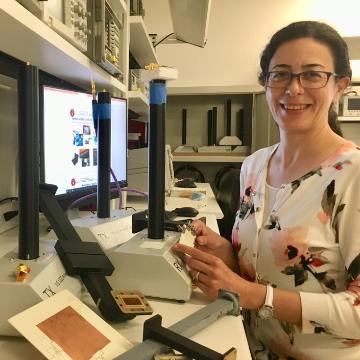A Magnetic Research Field

As a youngster, Ramesh Abhari, electrical and computer engineering department lecturer, found the field of electromagnetics magnetic. Drawn to the subject by its very mystery, she loved the deep thought process it took to make sense of it all and she knew she could figure it out. Now, with numerous patents granted or in the works, and with more than 100 journal and conference publications and 7 best student paper awards to her credit, she is even more passionate about putting her knowledge and creativity to work on what she considers “one of the main pillars of modern engineering.”
“I love designing something that no one has thought about. I love teaching and doing research, and I make every effort to bring out the best in my students,” she said in a tone more of wonder and excitement than of boastfulness.
The advent of 5G, IoT, artificial intelligence, and autonomous vehicles carries with it tremendous challenges. Engineers strive to advance technologies that enable the wireless connectivity needed to bring users into the modern age. “Antennas provide the wireless communication in our devices,” Abhari said. “In your 5G cell phone, there may be more than 20 antenna operating bands to enable different functions. But what happens in this miniaturized, crowded space is the same thing that happens in a room full of people all talking at the same time—noise and interference can prevent effective communication.”
In Abhari’s lab, researchers focus on enabling miniaturization while reducing noise and interference in applications that span from millimeter-wave antenna arrays to microwave hyperthermia. They also develop methods to manipulate the substrate upon which a system is built so it is operational at a lower frequency at a smaller size. “There are more than one trillion transistors and kilometers of interconnects on a 20cm wafer scale semiconductor chip that was recently developed for AI and deep learning computing. In this packed environment unintentional antennas can occur that cause cross-talk and interference. Data centers have the same problem, but at a different scale,” she explained.
Macro-engineering the substrate and power distribution network of high speed circuits is a specialty of Abhari’s. Her groundbreaking research in this area uses metamaterials to reduce noise generated from interconnects inside a board. Similar to the padding used by sound engineers to line the walls of their recording studios, metamaterials are employed and boards are engineered to absorb noise. “Through isolation enhancement techniques, we can filter, trap, and absorb the unwanted energy to create the perfect interconnect,” she said. Recently, her Ph.D. student Ali Khoshniat won 1st Place in the Student Hardware Design Contest at the IEEE International Symposium on Electromagnetic Compatibility, Signal, and Power Integrity Conference in New Orleans for his work on measurement of radiated electromagnetic noise from high-speed circuits and use of metamaterials for noise mitigation.
Abhari is excited about the results generated in her lab and about the prospects for her students. “This is a hot topic and our students are in high demand. They are learning the fundamentals of electromagnetics and gaining experience in innovative design—applying the same concepts, but using different strategies as demanded for diverse applications and environments,” she said.
The field that first attracted her attention as a youth continues to inspire the enthusiastic researcher to this day. “In a way,” she said, “with these advancements in wireless connectivity we are redefining our environment and ourselves. The sort of connectivity we have with our phones, wearable devices, and smart implants is another level of enhancing our senses. Remember the cyborgs from science fiction movies? We are almost there. Wireless connectivity is creating a smart skin for the Earth that acts as our extra sense.”